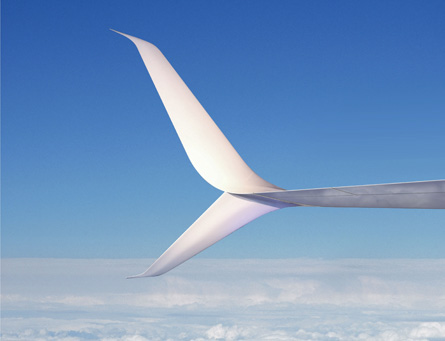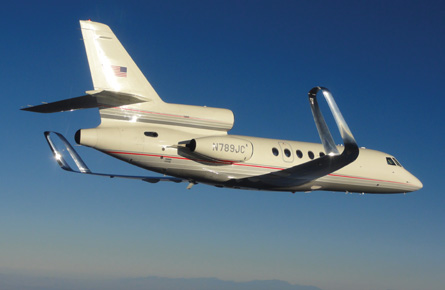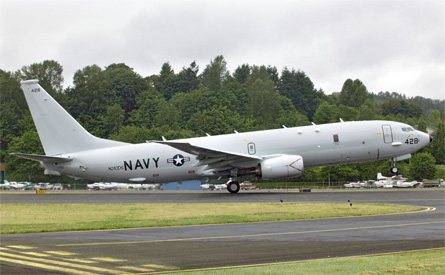Seattle-based Aviation Partners (API) is ready to flight test a slate of new technologies with the goal of allowing aircraft operators to boost fuel economy and correspondingly produce less carbon without the need to buy new aircraft.
"Fuel will be the most expensive commodity next to gold, so drag-reduction improvements are going to be important," says Joe Clark, president and founder of API. "With many of these aircraft, there's room for a 5-15% improvement in drag during cruise."
Along with variations on the winglet theme, including spiroids, split winglets and scimitar tips, API is also investigating ways to reduce drag with modified wing shapes and placement of vortex generators to prevent airflow separation just forward of the ailerons and spoilers, and in aft-body areas.
 |
|---|
| © Avation Partners One of Aviation Partners' innovations is split winglets with scimitar tips |
Less drag means less thrust required by the engines to maintain cruise speed, which corresponds to lower fuel burn at that speed. The new work comes on the back of API's success in the airline industry with its first wave of drag-reduction add-ons: blended winglets which API produces for business jets or for Boeing commercial airliners via Aviation Partners Boeing (APB) - its 55/45 joint venture with the airframer.
To date, APB has provided winglet kits for 4,400 Boeing 737s, 757s and 767s, saving operators an estimated 3.1 billion gallons of jet fuel as of mid-April, which corresponds to a carbon emissions saving of more than 33 million tonnes. The company estimates it will reach the "5 billion gallons saved" mark by the end of 2014.
Available for the 737-300/500/700/800/900, 757-200/300 and 767-300ER, the composite winglets decrease fuel burn anywhere between 1.9% and 5.6% for segments greater than 500nm (900km) in length, depending on the aircraft model, while increasing range and payload, take-off performance and aircraft residual value, says APB.
It adds that operators typically see an investment return on the $1 million winglets for the 737, not including installation, in less than two years.
"Airlines are primarily interested in fuel savings, but a number of them are interested in city pairs they can serve with the winglets," says APB president Bill Ashworth. The extra 2.1-5.2% fuel burn decrease for the 757-200 translates to an extra 180nm in range, a key element in 757s being used for transatlantic routes, for example.
"I spent my entire career in the [maintenance, repair and overhaul] business and installed a lot of winglets," says Ashworth, formerly the president of Goodrich Aviation Technical Services and former head of the US Federal Aviation Administration aircraft certification office in Seattle. "I heard many airlines talking about [winglets], saying it's the best bang for your buck that you can get. It's much less complicated than engine improvement programmes. Nothing moves and maintenance is inexpensive."
An augmented version of the blended winglet with a ventral fin and scimitar tips on both fins, called the "blended split winglet", was to begin flight testing on an API Boeing 737 on 25 April, Clark says. The appeal of the split winglet over more radical but higher performing options such as the spiroid, is that the split winglet can be retrofitted to an existing blended winglet.
FLUID DYNAMICS
Modifications would include peeling back the composite skin of the blended winglet and strengthening the structure to handle the ventral fin loads. It is not clear on the impact, if any, the ventral fin will make on low-wing aircraft in terms of roll allowances for take-off and landing.
Based on computational fluid dynamics (CFD), API thinks the split winglet with scimitars will reduce blended winglet drag an extra 2.5%. Blended winglets with scimitar tips alone provide a drag decrease of 0.5%. "On our last two projects, CFD predictions have been within one-tenth of 1% of flight test results", Clark says.
 |
|---|
| © Avation Partners API has tested its radical spiroid winglets on a Dassault Falcon 50 |
The more radical spiroid winglets API tested on a Gulfstream II in 1993 and most recently on a Dassault Falcon 50 business jet last year were proven to reduce long-range cruise drag by 11%. While significant, the idea of a cash-strapped airline replacing blended winglets with an all-new winglet likely to require costly modifications to the wing, is a non-starter. "We're looking at most of our technologies to be retrofittable," says Clark.
However, spiroids continue to be the topic of research for the next-generation air transportation system. The US government paid API $2 million for the spiroid-equipped Falcon 50 test data to evaluate wake turbulence information as part of an effort to determine if such technologies could reduce wake turbulence separation criteria to decrease in-trail aircraft separation distances. Clark says spiroids could eliminate wake vortices in the near-field region behind an aircraft.
API is also looking inward from the wingtip to gain fuel efficiency. "We're looking at ways to reduce drag by different shapes, changing wing shapes or vortex generators," says Clark. "At this stage, a lot of the work is in flow dynamics." He adds that the drag clean-ups are not uniquely targeted to jet transports but will also apply to business jets and turboprops., helping smooth non-optimal flow in the aft-body areas and preventing the separation of flow just forward of the ailerons and spoilers "on most aircraft". Clark says he plans to flight test some designs "in the fairly near future - probably this summer".
It is doubtful whether Boeing is looking at spiroids regarding fuel economy and environmental friendliness for its next generation 737 Max, targeted for entry into service in 2017 with Southwest Airlines, but tail section clean-ups are on tap. Boeing says the aircraft's tail cone will be extended and the section above the elevator thickened to improve steadiness of air flow. "This eliminates the need for vortex generators on the tail," the airframer says. "These improvements will result in less drag, giving the airplane better performance."
WINGTIPS MYSTERY
The wingtips remain a mystery. While all commercial 737 customers are selecting APB winglets for installation at the factory, Boeing continues to evaluate trade-offs between blended-type winglets and Boeing 777-style horizontally raked wing extensions used on the US Air Force's P-8A Poseidon, a variant of the 737-800. Max concepts have shown blended winglets. For other aircraft in production, optimal design work was carried out at the engineering stage, says Clark. "Certain aircraft are so superb there's not much you can do." Clark says the Boeing 777 has the "finest" wing. "There are a lot of others that need a lot of help though."
 |
|---|
| © Boeing Boeing continues to evaluate trade-offs between blended-type winglets and horizontally raked wing extensions used on the US Air Force's P-8A Poseidon |
Help may also come in the form of upkeep. Clark says API is considering "continuous improvement" programmes in which an operator would have an aircraft inspected every six months to a year to make sure drag reduction seals "are properly gapped and leading edge seals are not out of whack". "There's a lot of improvement that can be had," he says. "Seals get old and could be worn. We think there are ways to buy airlines or private jets another 4-5% in drag reduction due to the way the aircraft wear from a new-type state over the years."
Source: Flight International



















